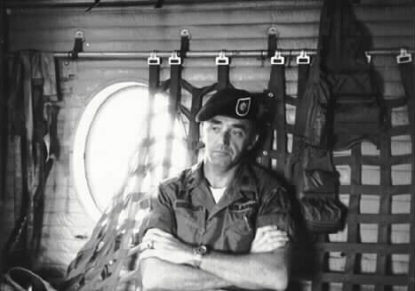William Buckley (William Francis Buckley)

During the Korean War, William Buckley served as a company commander with the 1st Cavalry Division. Next, he returned to Boston University and completed his studies, graduating with a degree in Political Science. It was during this time that Buckley began his first employment with the Central Intelligence Agency, from 1955 to 1957. He was also employed as a librarian in the Concord, Winchester and Lexington public libraries. In 1960, Buckley joined the 320th Special Forces Detachment which became the 11th Special Forces Group and attended both Basic Airborne and the Special Forces Officers Course. He was assigned as an A-Detachment Commander and later as a B-Detachment Commander. Colonel Buckley served in Vietnam with the U.S. Military Assistance Command, Vietnam, or MACV, as a Senior Advisor to the South Vietnamese army. In 1965 (or 1963, according to one source), William Buckley rejoined the CIA in what is now called the Special Activities Division. He may have been recruited by Ted Shackley, joining his Secret Team that had been involved with Edwin Wilson, Thomas Clines, Carl Jenkins, Rafael Quintero, Félix Rodriguez and Luis Posada Carriles, in the CIA assassination program. Leslie Cockburn pointed out in her book, Out of Control (1987), that Buckley was involved in approving CIA assassinations undertaken by the Shackley organizations. In his book, Prelude to Terror (2005) Joseph Trento claims that Buckley was “one of Shackley’s oldest and dearest friends.”
William Buckley may have been working for the CIA while in Mexico in 1963, but this is unconfirmed. His CIA employment kept him in Vietnam from 1965 to 1970, and he was promoted in his military capacity to Lieutenant Colonel in May 1969. After leaving Vietnam, he served in Zaire (1970–1972), Cambodia (1972), Egypt (1972–1978), and Pakistan (1978–1979). In 1983, Buckley succeeded Ken Haas as the Beirut Station Chief/Political Officer at the U.S. Embassy. Buckley was successfully rebuilding the network of agents lost in and due to the bombing of the U.S. Embassy; after the October 23, 1983 Marine Corps barracks bombing, the Islamist group Hezbollah wrongly announced that they had also killed the CIA station chief (they didn’t yet know the station chief was Buckley) in the blast; their announcement was the first real indication that he was on a Hezbollah “hit list.” On March 16, 1984, Buckley was kidnapped by Hezbollah from his apartment building when he was leaving for work. It was thought that one of the reasons he was kidnapped along with two other Americans at different times in Beirut was because of the upcoming trial of 17 Iranian-backed militants was about to begin in Kuwait. Army Major General Carl Stiner had warned Buckley that he was in danger, but Buckley told him that “I have a pretty good intelligence network. I think I’m secure.” However, according to Stiner, Buckley continued to live in his apartment and travel the same route to and from work every day.
William Casey, who was by then the Director of Central Intelligence, asked Ted Shackley for help in securing Buckley’s release. Three weeks after Buckley’s abduction, President Ronald Reagan signed National Security Decision Directive 138. This directive was drafted by Oliver North and outlined plans on how to get the American hostages released from Iran and to “neutralize” alleged “terrorist threats” from countries such as Nicaragua. This new secret counterterrorist task force was to be headed by Shackley’s old friend, General Richard Secord. This was the beginning of the Iran–Contra affair, which culminated in the exchange of missiles for the release of hostages. On November 22, 1985, Ted Shackley, William Buckley’s friend and recruiter, traveled to the Atlantic Hotel in Hamburg, where he met General Manucher Hashemi, the former head of SAVAK’s counterintelligence division. Also at the meeting on November 22 was Manucher Ghorbanifar. According to the report of this meeting that Shackley sent to the CIA, Ghorbanifar had “fantastic” contacts with Iran, but the CIA had designated him one year earlier as a “fabricator”. At the meeting, Shackley told Hashemi and Ghorbanifar that the United States was willing to discuss arms shipments in exchange for the four Americans kidnapped in Lebanon, although Buckley was already dead at this point.
Major General Carl Stiner stated that “Buckley’s kidnapping had become a major CIA concern. Not long after his capture, his agents either vanished or were killed. It was clear that his captors had tortured him into revealing the network of agents he had established.” According to the United States, Buckley had undergone 15 months of torture by Hezbollah before his death. On October 4, 1985, Islamic Jihad announced that it had executed William Buckley. The United States National Security Council acknowledged in an unclassified note that Buckley probably died on June 3, 1985 of a heart attack. Buckley’s remains were recovered by Major Jens Nielsen (Royal Danish Army) attached to the United Nations Observation Group Beirut on December 27, 1991. His body was returned to the United States on December 28, 1991, and he was buried in Arlington National Cemetery with full military honors.
Born
- May, 30, 1928
- USA
- Medford, Massachusetts
Died
- June, 03, 1985
- Lebanon
Cause of Death
- heart attack
Cemetery
- Arlington National Cemetery
- Arlington, Virginia
- USA


